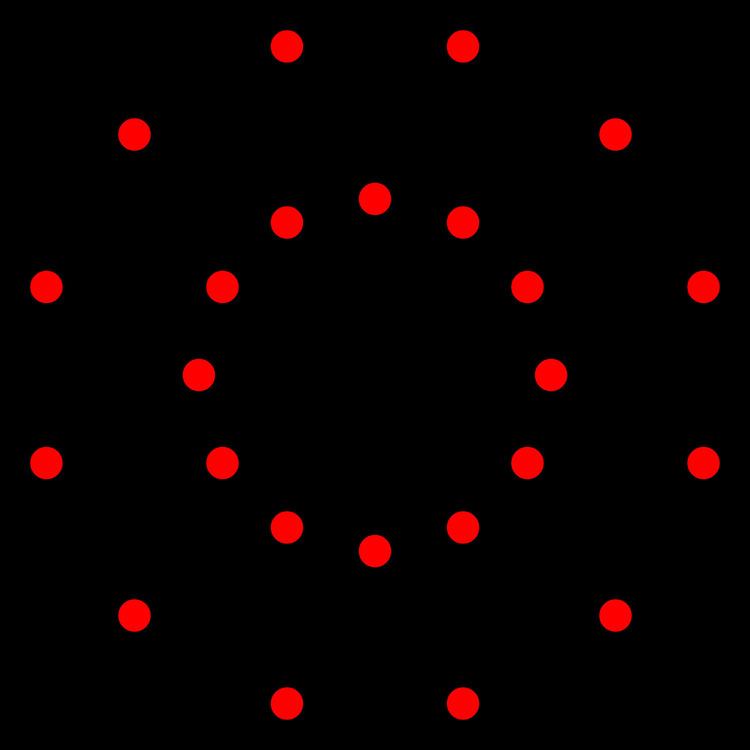 | ||
In four-dimensional geometry, a runcinated 24-cell is a convex uniform 4-polytope, being a runcination (a 3rd order truncation) of the regular 24-cell.
Contents
- Runcinated 24 cell
- Coordinates
- Related regular skew polyhedron
- Runcitruncated 24 cell
- Runcicantic snub 24 cell
- Runcic snub 24 cell
- Omnitruncated 24 cell
- Structure
- Full snub 24 cell
- References
There are 3 unique degrees of runcinations of the 24-cell including with permutations truncations and cantellations.
Runcinated 24-cell
In geometry, the runcinated 24-cell or small prismatotetracontoctachoron is a uniform 4-polytope bounded by 48 octahedra and 192 triangular prisms. The octahedral cells correspond with the cells of a 24-cell and its dual.
E. L. Elte identified it in 1912 as a semiregular polytope.
Coordinates
The Cartesian coordinates of the runcinated 24-cell having edge length 2 is given by all permutations of sign and coordinates of:
(0, 0, √2, 2+√2)(1, 1, 1+√2, 1+√2)The permutations of the second set of coordinates coincide with the vertices of an inscribed cantellated tesseract.
Related regular skew polyhedron
The regular skew polyhedron, {4,8|3}, exists in 4-space with 8 square around each vertex, in a zig-zagging nonplanar vertex figure. These square faces can be seen on the runcinated 24-cell, using all 576 edges and 288 vertices. The 384 triangular faces of the runcinated 24-cell can be seen as removed. The dual regular skew polyhedron, {8,4|3}, is similarly related to the octagonal faces of the bitruncated 24-cell.
Runcitruncated 24-cell
The runcitruncated 24-cell or prismatorhombated icositetrachoron is a uniform 4-polytope derived from the 24-cell. It is bounded by 24 truncated octahedra, corresponding with the cells of a 24-cell, 24 rhombicuboctahedra, corresponding with the cells of the dual 24-cell, 96 triangular prisms, and 96 hexagonal prisms.
Coordinates
The Cartesian coordinates of an origin-centered runcitruncated 24-cell having edge length 2 are given by all permutations of coordinates and sign of:
(0, √2, 2√2, 2+3√2)(1, 1+√2, 1+2√2, 1+3√2)The permutations of the second set of coordinates give the vertices of an inscribed omnitruncated tesseract.
The dual configuration has coordinates generated from all permutations and signs of:
(1,1,1+√2,5+√2)(1,3,3+√2,3+√2)(2,2,2+√2,4+√2)Runcicantic snub 24-cell
A half-symmetry construction of the runcitruncated 24-cell (or runcicantellated 24-cell), as , also called a runcicantic snub 24-cell, as , has an identical geometry, but its triangular faces are further subdivided. Like the snub 24-cell, it has symmetry [3+,4,3], order 576. The runcitruncated 24-cell has 192 identical hexagonal faces, while the runcicantic snub 24-cell has 2 constructive sets of 96 hexagons. The difference can be seen in the vertex figures:
Runcic snub 24-cell
A related 4-polytope is the runcic snub 24-cell or prismatorhombisnub icositetrachoron, s3{3,4,3}, . It is not uniform, but it is vertex-transitive and has all regular polygon faces. It is constructed with 24 icosahedra, 24 truncated tetrahedra, 96 triangular prisms, and 96 triangular cupolae in the gaps, for a total of 240 cells, 960 faces, 1008 edges, and 288 vertices. Like the snub 24-cell, it has symmetry [3+,4,3], order 576.
The vertex figure contains one icosahedron, two triangular prisms, one truncated tetrahedron, and 3 triangular cupolae.
Omnitruncated 24-cell
The omnitruncated 24-cell or great prismatotetracontoctachoron is a uniform 4-polytope derived from the 24-cell. It is composed of 1152 vertices, 2304 edges, and 1392 faces (864 squares, 384 hexagons, and 144 octagons). It has 240 cells: 48 truncated cuboctahedra, 192 hexagonal prisms. Each vertex contains four cells in an irregular tetrahedral vertex figure: two hexagonal prisms, and two truncated cuboctahedra.
Structure
The 48 great rhombicuboctahedral cells are joined to each other via their octagonal faces. They can be grouped into two groups of 24 each, corresponding with the cells of a 24-cell and its dual. The gaps between them are filled in by a network of 192 hexagonal prisms, joined to each other via alternating square faces in alternating orientation, and to the great rhombicuboctahedra via their hexagonal faces and remaining square faces.
Coordinates
The Cartesian coordinates of an omnitruncated 24-cell having edge length 2 are all permutations of coordinates and sign of:
(1, 1+√2, 1+2√2, 5+3√2)(1, 3+√2, 3+2√2, 3+3√2)(2, 2+√2, 2+2√2, 4+3√2)Full snub 24-cell
The uniform snub 24-cell is called a semi-snub 24-cell by John Horton Conway with Coxeter diagram within the F4 family, although it is a full snub or omnisnub within the D4 family, as .
In contrast a full snub 24-cell or omnisnub 24-cell, defined as an alternation of the omnitruncated 24-cell, can not be made uniform, but it can be given Coxeter diagram , and symmetry [[3,4,3]]+, order 1152, and constructed from 48 snub cubes, 192 octahedrons, and 576 tetrahedrons filling the gaps at the deleted vertices. Its vertex figure contains 4 tetrahedra, 2 octahedra, and 2 snub cubes. It has 816 cells, 2832 faces, 2592 edges, and 576 vertices.
